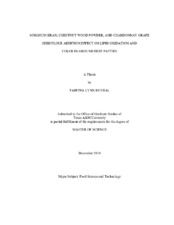| dc.description.abstract | Natural, plant-based tannin antioxidants are capable of inhibiting lipid oxidation in ground beef and may be possible alternatives to industry synthetic and natural standards of BHA/BHT and rosemary extract, respectively.
Ground beef was purchased on three different days, each defining a batch during study 1. Treatments, added based on meat weight, included a control, 0.2 percent rosemary (RM), 0.02 percent BHA/BHT, 0.5 percent Chardonnay grape seed flour (CG), 0.1 percent and 0.25 percent chestnut wood flour (CN), and 0.25 percent and 0.5 percent of four sorghum bran varieties: black (BS), black with tannin (BTS), white (WS), and high tannin (TS). Patties, formed in duplicate, were randomly designated as cooked or raw and by 0 to 5 day storage, and were aerobically stored at 4 degrees C. Cooked patties were analyzed using the TBARS method. Raw patties were analyzed for subjective and objective color, number of ingredient specks, and pH.
In study 2, six treatments were chosen for sensory evaluation including a control, 0.2 percent RM, 0.02 percent BHA/BHT, 0.5 percent CG, 0.1 percent CN, and 0.5 percent BTS. Preparation, and raw and cooked analysis occurred similar to study 1. Additional patties were made for day 1 consumption by consumer panelists.
In study 1, all treatments except 0.25 percent WS reduced TBARS values over time compared to 0.2 percent RM. Four treatments (0.5 percent BTS, 0.5 percent CG, 0.25 percent CN, and 0.1 percent CN) showed no significant increase in TBARS values over storage. BS and BTS yielded the lowest color space values (CIE L*, a*, and b*; P<0.0001). Ingredient specks were possible color measurement influences.
In both studies antioxidant addition reduced TBARS values over time compared to the control (P<0.0001), and percent discoloration was highest in patties containing a sorghum treatment (P<0.0001).
Patties containing 0.1 percent CN were significantly favored in terms of overall like (P<0.0002) and flavor like (P<0.0001). Patties containing 0.2 percent RM were ranked lowest in overall and flavor like, and ground beef-like bite. Patties containing 0.5 perent CG were least liked according to tenderness level (P<0.005).
These results indicate that CG, CN, and certain varieties of sorghum bran can be added to pre-cooked ground beef products and provide better antioxidant protection than currently used ingredients of BHA/BHT and rosemary extract. | en |


